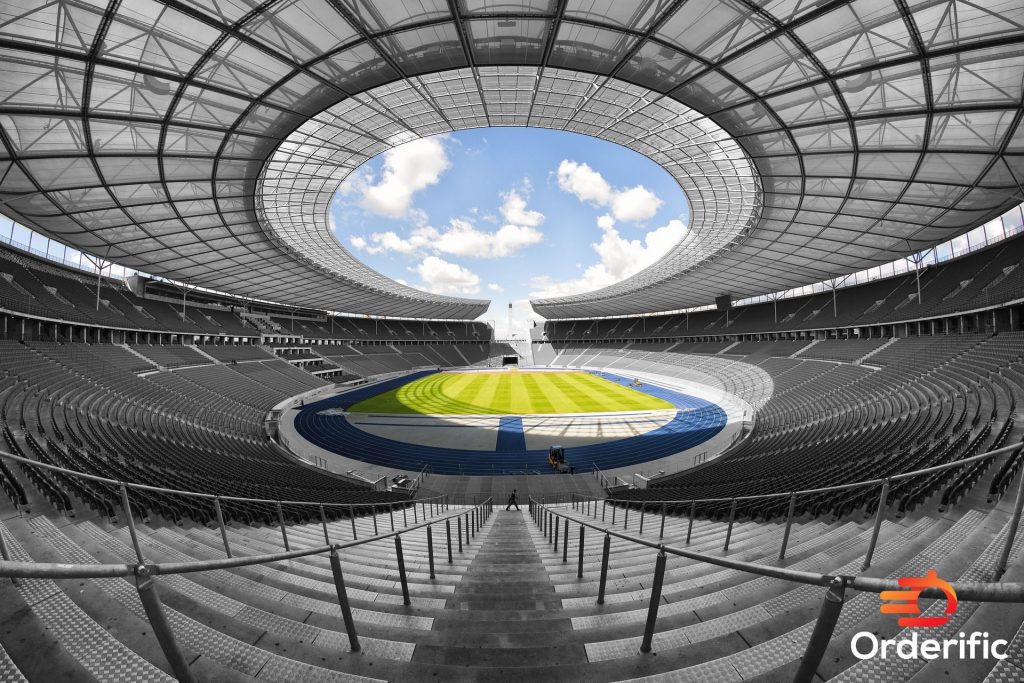Over the years, history of sports facility management has experienced a remarkable evolution, driven by technological advancements and industry trends. This transformation has not only enhanced the operational efficiency but also elevated the overall quality of sports facility management. From the grandeur of stadiums to the versatility of arenas and the accessibility of recreational facilities, the management of sports venues demands a unique blend of business acumen and sports management expertise.
In the ever-evolving world we live in, the pursuit of delivering an unparalleled fan experience has emerged as a top priority for sports venues across the globe. This has sparked a wave of innovation, giving rise to digital ticketing systems that streamline entry, interactive seating maps that empower fans to choose their ideal seats, and mobile concessions ordering that brings convenience to the fingertips of spectators.
The History of Sports Facilities & Their Location Selection
Sports facilities boast a captivating history spanning centuries. From the majestic ancient Olympic stadiums in Greece, where athletes vied for divine approval, to contemporary marvels like Atlanta’s iconic Mercedes-Benz Stadium, the evolution history of sports facility management has been mesmerizing.
One of the most intriguing aspects of this industry lies in the meticulous selection of locations for these remarkable structures. Facility management teams face the complex task of considering numerous factors, such as accessibility, population density, revenue potential, and even cultural significance. The decision of where to build a sports facility is a delicate balance between practicality and symbolism, as these venues often become symbols of pride and identity for the communities they serve.
It is hardly astonishing that numerous iconic sports venues located in bustling urban areas, where one can find an abundance of people and vibrant energy. These venues offer cultivate a vibrant ambiance, enhancing the overall experience for athletes and spectators alike. From the roar of the crowd to the city skyline as a backdrop, the urban setting adds an extra layer of excitement and spectacle to sporting events.

Journey Through Time
Delving into the history of sports facility management and their location selection is like embarking on a captivating journey through time, data, and the intricate decision-making processes that shape the sports industry. Exploring these intricacies allows us to appreciate the significant role that sports facilities play in our society, connecting communities, fostering athletic excellence, and creating unforgettable moments that transcend generations.
Furthermore, the ongoing advancements in technology and design continue to push the boundaries of what is possible in sports facilities. Innovations like retractable roofs, augmented reality experiences, and eco-friendly infrastructure are shaping the future of sporting venues. These advancements enrich the overall fan experience rendering sports facilities more environmentally friendly.
The combination of historical significance, strategic location selection, and technological advancements in sports facilities creates a captivating tapestry that weaves together the past, present, and future. As we continue to witness the evolution of these architectural marvels, we can anticipate that the future of sports facilities will be just as awe-inspiring as their storied past.
The Role of Technology in Sports Facility Management
Technology has played an incredibly significant role history of sports facility management. With the advent of smart stadiums equipped with cutting-edge technology and advanced data analytics, the way facilities are managed and how fans interact with their favorite teams has been completely transformed.
The advent of technology has brought about a significant transformation in the realm of sports. One notable outcome is the proliferation of social media platforms, which have revolutionized the way sports facilities connect with their fans. By providing real-time updates, exclusive behind-the-scenes content, and interactive experiences, these platforms empower facilities to forge stronger bonds between fans and their beloved teams. This unprecedented level of engagement fosters a deeper sense of connection and amplifies the overall fan experience.
By providing an enhanced fan experience, facilities elevate the overall atmosphere and unlock novel marketing and sponsorship opportunities. This enables them to connect with a broader and more diverse audience, expanding their reach and impact.
Operational Efficiency
Moreover, technology has greatly enhanced the efficiency of facility operations. Automated systems for ticketing, concessions, and maintenance have streamlined processes and reduced manual tasks for managers. By doing so, they can allocate more attention towards crafting extraordinary experiences for fans while optimizing the utilization of resources. This leads to cost savings and the adoption of enhanced sustainability practices.
In addition to these advancements, technology has also revolutionized the way sports facilities are designed and constructed. Virtual reality and 3D modeling tools enable architects and designers to visualize and optimize the layout of stadiums, ensuring optimal viewing angles, seating arrangements, and overall fan comfort. This level of detail and precision contributes to creating immersive and unforgettable experiences for spectators.
Furthermore, technology has facilitated the implementation of enhanced safety and security measures within sports facilities. From advanced surveillance systems to biometric access controls, these technologies ensure the well-being of fans and staff, providing a secure environment for everyone.
In summary, technology has revolutionized sports facility management by empowering facilities to enhance fan engagement, expand their reach, and improve operational efficiency. As technology continues to advance, we can anticipate even more exciting developments in the future that will further transform the way sports facilities are managed and experienced. The possibilities are truly limitless!
The Growing Importance of Sustainability in Sports Facilities
Sustainability has become a growing focus in the sports industry, with history of sports facility management taking significant strides towards implementing eco-friendly practices. As climate change continues to be a pressing issue, facilities are recognizing the importance of reducing their environmental footprint. They are going beyond basics and embracing comprehensive green initiatives to create a lasting impact.
These initiatives include not only using renewable energy sources but also exploring innovative ways to generate clean power on-site. Sports facilities are increasingly investing in solar panels, wind turbines, and other sustainable energy solutions. By harnessing the power of nature, they are not only reducing their carbon emissions but also creating a more resilient and self-sufficient energy infrastructure.

Energy-Efficient Infrastructure
Moreover, promoting recycling and composting has become a norm in these facilities. They are setting up dedicated waste management systems that encourage fans and staff to recycle and compost their waste. This not only diverts a significant amount of waste from landfills but also contributes to the circular economy by turning organic waste into valuable compost.
To go even further, sports facilities are now incorporating sustainable materials in their building and maintenance processes. They are using recycled and low-impact materials for construction, ensuring that the entire lifecycle of their infrastructure aligns with sustainable principles. From energy-efficient lighting systems to water-saving fixtures, every aspect of the facility is designed to minimize resource consumption and environmental impact.
In addition to these efforts, many venues are also implementing sustainable transportation options for fans. They are partnering with bike-sharing programs, facilitating public transportation access, and encouraging carpooling to reduce the carbon footprint of spectators traveling to events. By providing convenient and eco-friendly transportation alternatives, sports facilities are not only reducing traffic congestion but also promoting healthier and more sustainable ways of commuting.
Community Engagement
As sustainability becomes a top priority for consumers, sports facilities are realizing the need to adapt and lead by example. By embracing eco-friendly practices, they are not only fulfilling their environmental responsibilities but also gaining a competitive edge in the market. Being perceived as responsible members of their communities, sports facilities can attract environmentally conscious fans, sponsors, and partners who value sustainability as an integral part of their decision-making process.
In conclusion, sustainability is no longer an afterthought in sports facility management. It has become a fundamental pillar that drives innovation, cost reduction, and community engagement. As the sports industry continues to evolve, these facilities are at the forefront of creating a greener and more sustainable future for both sports and the planet.
The Future of Sports Facility Management
As technology continues to advance and consumer expectations shift, the future of sports facility management is brimming with potential. The use of virtual and augmented reality can bring forth new and exhilarating experiences for fans, immersing them in the world of sports like never before. With these innovative technologies, fans can witness the thrill of a game from different perspectives, virtually stepping onto the field or court alongside their favorite athletes.
Moreover, data analytics will continue to play a crucial role in decision-making processes for sports facility management. By harnessing the power of data, sports facility managers can gain valuable insights into fan preferences, optimizing operations and enhancing the overall fan experience. From personalized recommendations for concessions to tailored seating arrangements, data-driven strategies will revolutionize how sports facilities connect with their audience.
E-sports and Non-traditional Leagues
As the sports landscape evolves, the rise of e-sports and non-traditional sports leagues presents new opportunities and challenges for sports facility management. These emerging forms of sports entertainment may require flexible and adaptable spaces to accommodate their unique events and fan bases. From state-of-the-art gaming arenas to multi-purpose facilities, the ability to meet the diverse needs of these evolving sports will be crucial for sports facility managers.
In addition to technological advancements, the integration of smart technology and sustainability efforts will shape the future of sports facilities. Smart stadiums equipped with Internet of Things (IoT) devices can optimize energy usage, improve facility maintenance, and enhance the overall fan experience. From automated lighting systems that adjust based on occupancy to smart ticketing solutions that streamline entry, the possibilities for creating efficient and eco-friendly sports facilities are endless.
Beyond infrastructure and technology, an unwavering focus on creating an unforgettable fan experience will be vital for the success of sports facilities in the future. Engaging fans through interactive displays, immersive fan zones, and unique amenities will foster a sense of community and loyalty. By continually innovating and surprising fans with delightful experiences, sports facility managers can cultivate lifelong supporters who keep coming back for more.
Shaping the Future Together
Amidst all these changes and advancements, one thing is certain – the future of sports facility management will be anything but dull. This dynamic field will continue to attract individuals with diverse backgrounds and skill sets, bringing fresh perspectives and driving innovation. The convergence of sports, technology, and entertainment will create a vibrant ecosystem where creativity and collaboration thrive.
So, let’s embark on this exciting journey together as we shape the future of sports facilities for generations to come. With limitless possibilities and constant evolution, the future of sports facility management holds the promise of unforgettable experiences, groundbreaking innovations, and a deep connection between fans and their favorite sports. We eagerly anticipate the next game-changing moment in this captivating field. See you at the next game!

Sports Facility Design & Planning
Sports facility design and planning is a highly critical and multifaceted aspect of the sporting industry. It encompasses much more than merely constructing a physical space; it entails optimizing the potential of athletes and enthusiasts to perform at their absolute best. Through meticulous planning and thoughtful design, sports facilities can evolve into inspiring hubs that foster growth, development, and achievement.
Every aspect of facility design is carefully considered, from the layout of the space to the choice of materials. These factors are all aimed at creating an environment that not only enhances performance but also captivates spectators. The arrangement of training areas, the selection of cutting-edge features, and the integration of innovative technology all contribute to the overall experience of athletes and spectators alike.
However, the success of a sports facility does not solely rely on its design and planning; effective facility management is also of utmost importance. Facility managers play a vital role in supervising staff, ensuring safety measures are in place, and maintaining equipment to guarantee optimal performance. Their dedication and expertise contribute to creating a safe and functional space for athletes to thrive.
Role of Effective Facility Management
To revolutionize sports facility design and planning, the utilization of data and information is crucial. By leveraging advancements in technology and incorporating data-driven insights, planners and designers can elevate facility design to unprecedented levels. This can result in state-of-the-art facilities that provide innovative training spaces, immersive experiences, and cutting-edge features, ultimately enhancing players’ performance and overall experience.
In conclusion, sports facility design and planning go far beyond the construction of a building. It involves the creation of an environment that cultivates excellence, inspires achievement, and elevates the entire sporting experience for athletes and spectators alike. By paying attention to every detail and continuously striving for improvement, sports facilities can become true symbols of athletic excellence and innovation in the industry, leaving a lasting impact on the world of sports.
The Importance of Collaboration in Sports Facility Management
Collaboration is not only essential but also the backbone of effective sports facility management. It involves seamless coordination among diverse teams and departments, all working in harmony to ensure the smooth operation of the facility. This collaborative effort encompasses facility managers, event coordinators, marketing teams, and maintenance staff, all synergizing their skills and expertise toward a common goal.
By fostering a culture of collaboration, sports facilities can achieve remarkable success in creating exceptional experiences for fans while maintaining a safe and efficient environment. However, the significance of collaboration extends beyond the facility walls. It permeates the entire sports industry, emphasizing the value of partnerships between sports facilities and local businesses or organizations.
These partnerships bring forth a wealth of resources and opportunities, benefiting both parties involved. By establishing strong relationships within the industry, sports facility management teams gain access to new ideas, technologies, and strategies that enhance the overall success of their facility. Moreover, collaboration not only promotes growth and innovation but also strengthens the sports community as a whole.
In an era of technological advancements, collaboration becomes even more critical in sports facility management. As new technologies emerge, the sharing of knowledge and expertise among industry professionals becomes paramount. By embracing collaboration, sports facilities can stay at the forefront of innovation, ensuring continued success in managing and enhancing the sports experience for all stakeholders.
Creating Exceptional Fan Experiences
In summary, collaboration is the cornerstone of effective sports facility management. It enables seamless operations, exceptional experiences for fans, and fruitful partnerships within the industry. As the sports landscape evolves, collaboration will remain an essential and ever-growing aspect of successful sports facility management.
Through collaborative efforts, sports facilities can leverage the power of teamwork to optimize facility operations and enhance the overall experience for athletes and fans alike. By fostering open communication and cooperation, facility managers can ensure that every aspect of the facility, from event logistics to maintenance and marketing, is aligned and working towards a shared vision. This attention to detail and comprehensive approach sets the stage for memorable experiences that leave a lasting impression on visitors.
Furthermore, collaboration extends beyond the facility walls to encompass partnerships with local businesses and organizations. These alliances bring together the resources and expertise of various stakeholders, creating a network of support that not only benefits the facility but also enhances the surrounding community. By working hand in hand with local businesses, sports facilities can tap into additional funding, sponsorship opportunities, and community engagement initiatives that further elevate their impact.
Comprehensive Approach for Memorable Experiences
In the ever-evolving landscape of sports facility management, collaboration serves as a catalyst for innovation. By embracing emerging technologies and sharing knowledge among industry professionals, sports facilities can stay ahead of the curve and continuously improve their operations. From implementing state-of-the-art security measures to incorporating cutting-edge sustainability practices, collaboration enables facilities to adapt and thrive in an increasingly competitive market.
In conclusion, collaboration is the lifeblood of effective sports facility management. It strengthens relationships, drives innovation, and enhances the overall experience for all stakeholders involved. By embracing collaboration as an ongoing practice, sports facilities can pave the way for a successful and sustainable future in the dynamic world of sports management. With a collaborative mindset, the possibilities for growth and achievement are limitless.
Conclusion
In conclusion, the data gathered on sports facility management presents some truly fascinating and thought-provoking findings. By exploring the intricacies of sports facility management, we can delve into various aspects, such as the evolving trends in facilities’ utilization and the profound impact of new technologies and their applications in the field.
By emphasizing the significance of sports facility management, we gain a deeper understanding of how these centers can evolve into thriving hubs for athletic competition, catering to both professional athletes and individuals seeking to enhance their fitness. From a business perspective, the efficient maintenance of sports facilities becomes paramount in minimizing expenses while maximizing revenue streams.
Looking towards the future, the success of sports facility management may heavily rely on our ability to gather and harness new data insights. These valuable insights will enable us to optimize these centers to cater to the needs of athletes and fans alike, creating an unparalleled experience in the world of sports. Schedule a FREE DEMO today to explore how Orderific can revolutionize your restaurant operations. Embrace the future, where technology harmonizes with tradition, and experience the incredible impact with Orderific.
FAQs
How did the concept of sports facility management originate and evolve over time?
The concept of sports facility management has evolved over time as a result of advancements in technology and changes in industry trends.
What key milestones have marked significant developments in the history of sports facility management?
Some key milestones in the history of sports facility management include the introduction of digital ticketing and mobile concession ordering.
Are there specific trends or innovations that have shaped the historical landscape of sports facility management?
Yes, there have been several trends and innovations that have shaped the historical landscape of sports facility management, including advancements in technology.
How has the role of technology changed in sports facility management throughout its history?
The role of technology has greatly evolved in sports facility management with advancements in data gathering and analytics, facilities have access to a wealth of information.
What are some notable success stories or challenges faced by sports facility managers in different eras?
Some notable success stories in sports facility management include the renovation of Wembley Stadium in London and the construction of Mercedes-Benz Stadium in Atlanta.













